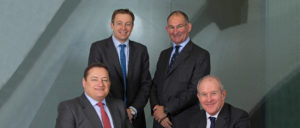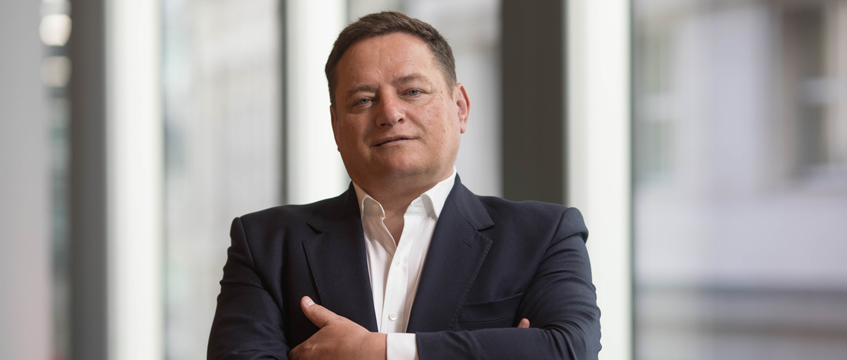Two years and three months since Cushman & Wakefield and DTZ’s mega-merger and the new business is positioning itself for further growth.
A management reshuffle announced last week saw John Forrester promoted to the new position of global president. He was replaced as EMEA chief executive by Colin Wilson, who in turn was replaced as head of UK & Ireland by George Roberts (former head of London markets). Digby Flower continues as chairman UK & Ireland, Carlo Barel di Sant’Albano remains EMEA chairman, and a raft of further internal promotions are expected.
Positioned for growth

“Our ambition to grow is real, and that includes the number of colleagues we have around the world, and the growth comes from doing more things,” says Forrester, who in his new role is responsible for the operational and management responsibilities for the company’s 45,000 employees in more than 70 countries, which generate revenue of $6bn (£4.5bn).
Based in London, he will travel regularly between offices to make sure clients “receive the same service in the same way in the same language and the same structure in every part of the world that they operate.”
He says: “The globalisation of the industry is very mature and therefore the role of global president is really taking best practice from one area to another and making sure we’re not reinventing the wheel for every situation but we’re doing it once and we’re doing it brilliantly.”
The business is on an acquisition drive – buying three European businesses since the merger: Cogest Retail (Italy); DTZ Zadelhoff (Netherlands); and design and build company ADMOS (Belgium and Luxembourg). “I think that’s a momentum we would like to maintain, if not speed up on, because these are the things that we don’t do at the moment that we would like to do,” Forrester says.
Acquiring more design-and-build companies such as ADMOS in other countries to create a global platform is one ambition. However, Forrester says he sees opportunities in every area where the business operates: “We are acquisitive on every platform where we have significant gaps and where we are not market leader,” he says.
The UK business recently hired three new staff to its student accommodation team – another expansion area where it is choosing to recruit existing market specialists rather than upskill internally. Chief executive Brett White summed up the company’s global growth plan last week: “making strategic acquisitions, adding services, and taking market share”.
Preparing for an IPO?
Market observers have speculated whether the restructure is part of Cushmans’ preparations for an IPO, which White said last year was the most likely exit for the company’s owners. Private equity group TPG holds 50% of the business, PAG Asia Capital 35%, and Ontario Teachers’ Pension Plan 15%. Forrester admits a listing is still the most likely exit for the company’s owners.
“We are a large real estate services organisation, and therefore that is the most likely route ultimately that we will follow,” he says. However, he declined to comment on when or where it would happen. “The context of this team and how we work, is to say to people: “Look at how pleased we are and proud we are of what we’ve achieved – not promises of what we haven’t done yet. We want to do a lot, and when we’ve done it, then we’ll tell you.”
Automation risk
How do you make an advisory business at risk of being automated into an attractive IPO? “I think every area of our historic business is under potential threat of change, through either automation, or disintermediation, or third parties coming in,” Forrester says. “There are more areas for us to grow into and be excited about – genuinely. So, I don’t think that’s an IPO-related question. That’s asking: is it a good industry? My son’s just come into the industry and I think it’s going to be a great industry to come into – but it will be very different, that’s for sure.”
Parts of the advisory world has already been automated – residential conveyancing has been turned into a process. Other processes involved in sales and leasing will also become automated. However, Cushmans sees the real opportunity in giving expert advice on the end user of real estate.
“If you speak to our clients and ask them what really matters to you on the agency side, they will all say the same thing, which is they want to know what the end user is saying, what the end user is doing, what the end user’s going to do,” says George Roberts. “We have a tremendous opportunity in particular in our firm, to position ourselves differently from others by having the best insight into what these end users are saying.”
‘Brain power’
The “brain power” goes into the advisory part of the business, says Digby Flower. That’s putting together complex sites or doing complex deals. “Where businesses will fail is where you’ve got expensive people doing the stuff on the left-hand side of the line which can actually be automated. That doesn’t work, and that’s where you’ve got to be disciplined about doing things and if you can make it efficient, that’s a good business model going forward for the transaction side.”
He cites a pitch last week which came in with 36 hours’ notice. The London team spent a day working on it and then the New Zealand team did all the document production through the night in what was their day. With the market showing signs of softening, and global political risks in abundance, is now a good time to expand?
“We definitely need to be cognisant of some of those headwinds, many of which tend to create short-term issues” says Colin Wilson, who cites the short-lived quietening of the London market around the EU Referendum vote. “I think we realise that we are probably in a different cycle now, because this isn’t one which is being borne out of either a lack of capital or an abundance of stock. If anything, those two factors are probably more in balance than they ever have been.”
Forrester adds: “For us strategically what we do see as where we are late in the cycle, is to ensure that we are growing and have very significant levels of recurring revenues in the organisation so we’re less susceptible to a cycle change. As a global organisation we have extremely large areas in facilities management, contract work for clients, and we’ll be looking to be acquisitive in growing that. But we are no different from any of our peers as well who are seeking to become less reliant on transactional work to drive the organisation’s health.”
Talent retention
In the UK, the business has suffered from high-profile departures this year, including head of London investment James Beckham (to CBRE) and tech specialist Juliette Morgan (to British Land). Forrester points out the business’s attrition rate is low. But how will Cushmans fill the hole left by Beckham, who led its involvement in the record-breaking 20 Fenchurch Street and 122 Leadenhall Street, EC3 sales this year? Forrester rules out buying a niche agency to bolster its London team and says the former role of George Roberts, head of London markets, will be an internal promotion.
“The simple reason [for not acquiring another firm] is, we are somewhere where people want to work at the moment,” Forrester says. “Finding real talent is not as difficult as it has been in the past.” He adds: “We will never stop trying to grow in London – we just have to get a relentless view that this city is one of the most important markets in the world and for us to be relevant as an organisation in the world we have to be extremely relevant in London.”
On the future of the tech advisory business, Forrester says Cushmans has taken its understanding of what proptech was doing and could do to the industry and “embedded” it in the company. “So, instead of having a department or a team, we’re working with every single part of our business, giving them support and resources to look at how they do things and how they are going to do things in the future.”
Forrester hopes the business’s talent retention will in part be driven by a start-up, disruptor spirit. “I think the merger has created so much energy around change, where actually no-one at Cushman & Wakefield works for the same organisation that they did work for,” says Forrester. “It’s a brand new organisation, I often liken it to the biggest start-up there is.” The company is building a Future Network for employees who want to discuss challenging ways of working. Roberts says the programme, of which more information will be announced in due course, is already oversubscribed.
A different-looking future?
Forrester sees the irony in a group of four middle-aged white male leaders preaching about diversity. However, he says the company is already taking steps to make the future leaders look different.
“We’re all a certain type and we’re very aware of that. I think when you look at our next level of announcements of leadership across the company you’ll see a different kind of diversity which
we’ll be very proud of through age, gender and background.
“Our clients come in every possible shape, form, size, everything, so that’s what we need to be and we have a relentless challenge to achieve that, and it’s a challenge because it isn’t easy
because you have to attract people in, make them feel welcome and see that there are opportunities for everyone.”
While there is plenty of change, he sees his primary leadership duty as providing continuity. “We see challenges every day, we see changes every day, and if you flip-flopped all the time from comfort to panic or from fast to slow, I think the larger the organisation you were working within the more difficult it would be to maintain continuity and consistency and a real view that people can invest their career here”.
Forrester has certainly been a force of stability at the company – joining DTZ as a 25-year old when the company comprised 240 people. It has since reinvented itself five or six times, becoming European, expanding into Asia, and then establishing itself as a global business. He led the formal sale to UGL in 2011 and was a key player in the 2015 merger.
Why has he stayed so long? “I’ve never had to leave the organisation to find a challenge,” he says. “I’m a long, long way away from being the most intelligent, or the best looking, or any of those things, so maybe what I do have to offer is I’ve been working for this organisation for an awfully long time, and understand how it works, and therefore if we can continue the core essence of what we are, into whatever organisation we become, that to me is leadership – it’s what people can look for in their future, not what I do.”
To send feeback, email louisa.clarence-smith@egi.co.uk, or tweet @louisaclarence or @estatesgazette.











